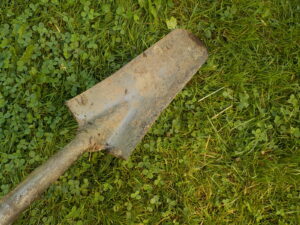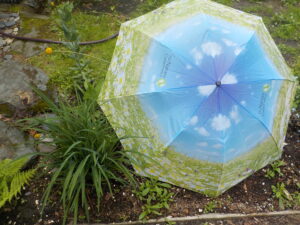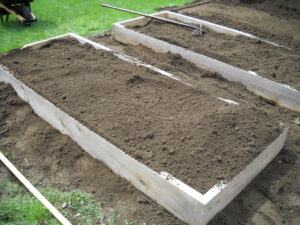Planting, Transplanting and Moving Plants
Posted on Wednesday, June 14, 2023 · Leave a Comment
Once, a long time ago, I was sitting on a porch overlooking a landscape with an acquaintance. I commented that if she removed or thinned a line of tall pine trees, she would have a lovely long view. “Great idea! I’ll have them moved,” she said. Even though she was a woman of means, I explained that it wouldn’t be possible to move 60-foot white pines. She should either live with them or cut some down.
On the other hand, I move shrubs and perennial flowers regularly. Done right, a plant barely knows it’s been moved. I have a number of reasons for moving a plant.
First, if the plant is not growing well. Perhaps the tag on it said, “Sun or Part shade.” Well, what is part shade? I define full sun as 5 or 6 hours of afternoon sun. Morning sun is less hot, and a sun-lover might want some afternoon sun in addition to the morning sun.
Why else move a plant? We all change our minds. Or plants grow and start to crowd out their neighbors. We get new plants and decide to plant one where something else is already growing. Moving plants is a normal part of gardening.

Calycanthus or sweetshrub is a shade-loving shrub that I moved twice to find it a happy home
I have a lovely shrub called Carolina sweetshrub or Calycanthyus floridus. My reference book by Michael Dirr, “Manual of Woody Landscape Plants” suggests planting it in sun or shade in deep moist loam. I planted it in full sun in deep, moist loam and the leaves burned that first summer. I assumed it had been grown in a shady place at the nursery, so figured it would be fine in Year 2. It was not. Its leaves burned again. So that fall I moved it to a shady spot.
For the next three years or more my sweetshrub did not burn up in summer, but neither did it flower much. I wanted those deep burgundy wine-colored blossoms, each more than an inch across. So I finally moved it again – this time under a pear tree that allowed filtered sunshine. Perfect! It has bloomed magnificently ever since.
My technique for moving a shrub is simple. I decide where it should go, and get the area ready by removing grass or plants and loosening the top layers of soil. Then I go to the plant if question with a drain spade that has a blade 16 inches long and only 5 inches wide. I slide it under the shrub on all four sides by thrusting the blade into the soil at a 45 degree angle. On each side I give the spade a gently downward push to lift and loosen the shrub a little. By the fourth thrust, it should be ready to lift out by sliding my two hands under the root ball.

This drain spade is good for transplanting perennials and shrubs
I move the shrub into a waiting wheelbarrow and bring it to its new home. I measure the depth of the rootball and dig out a hole deep enough so that it will sit at the same depth it was originally. I dig a wide hole so that the area around the shrub will be nicely loosened and ready for roots to grow in it once I back fill the hole. I water well that day, and regularly all summer.
When I water a plant I have moved, I add something to the water: a capful (half a teaspoon) of something called “Superthrive” in a watering can of water. It was developed some 70 years ago and uses seaweed extracts and plant hormones to lessen transplant shock. I find it really helps. A small blurt of Neptune’s Harvest Fish and Seaweed fertilizer in the water adds some quick nutrition. I use both liquids on all my vegetables as I plant them, too.
Any plant that you planted this year can be moved now without damaging it. It takes several weeks before roots move far from their rootball. I don’t bother with a spade when moving new things. I use my CobraHead weeder which is shaped like a long curved finger. It gets under the rootball easily, and by wiggling it around I can loosen the plant and gently lift it out, pulling from below with my CobraHead.

An umbrella cah shade a stressed plant until the sun goes down
When I am moving an established perennial, I am more careful. Over the years – both from experience and readings – I have learned much about the root systems of common perennials. You probably have, too. Some have roots near the surface while others are more like tubers that go deep.
Peony roots go deep, and are not easy to move without breaking their fleshy tubers. Peony experts say to move them in the fall, when they are going dormant. But I once moved a hedge of peonies in June with about 50 plants, and not one showed ill-effects.
It is best to move established perennials in the early evening, or on a cool or drizzly day. Some plants go into shock if disturbed in the heat of the day, so avoid doing so if you can. Others, like daylilies, don’t care at all about being moved on a hot dry day.
I recently was planting my front walkway garden and noticed a Rudbeckia called ‘Prairie Sun’ that was too close to another plant, so I moved it at 11am on a hot day. After lunch the leaves were limp and it was in distress. My solution? I gave it another drink of Superthrive and placed an umbrella over it to provide shade. By the next morning it looked like it had never been moved!
So go ahead, move plants. Other than big trees, there are very few you can’t move.
Henry is the author of 4 gardening books. He is a gardening consultant and speaker for garden clubs and library groups. Reach him at
henry.homeyer@comcast.net.
This Year’s Lessons from the Garden
Posted on Tuesday, December 27, 2022 · Leave a Comment
At the end of the year I always like to take a little time to reflect on what worked well in the garden – and what didn’t. This year I also called some gardening friends – some experienced, some less so – to ask what they had learned so I could share their thoughts with you, my loyal readers.
I’ll go first. In 2021 I planted some bare root oaks I bought from the State of New Hampshire and planted them for a client in an open meadow in what had previously been a lawn. Most did well last year and really took off this year. Based on that success, I planted even more this year in part because I could get unusual trees not available locally – northern pecan, hardy persimmon, pawpaw and more. We’ll see how they do next year.

Peonies are best divided or transplanted in the fall but can be moved anytime
Bare root trees are usually the thickness of a pencil and have a foot or so of root with 18 to 24 inches of bare trunk. Although I found a grower in Vermont willing to sell them to me, most growers sell them to nurseries that pot them up and sell them in a year or two. But if you go on-line you can find growers who will ship bare root trees and shrubs in the spring. They are easy to ship – no soil is included – and are less expensive than trees that have been tended and watered for a couple of years.
The downside is that bare root trees are generally only sold when dormant, and need to be planted soon after arrival. Some growers keep big coolers full of bare root material, but you still need to get them in the ground soon after you get them. Look for them now and order what you want for spring delivery.
A friend bought a house in southern New Hampshire and had her first vegetable garden this year. She was surprised and delighted that there was no blight on her tomatoes. This did not surprise me at all. The fungus that blights so many tomatoes lives in the soil, and in a new location it rarely shows up until year two.

Raised beds need to sit on soil with good drainage
She also reported that some of her new raised beds were placed on ground so hard that she couldn’t even get a shovel in it. The wood beds were 8 inches tall, but didn’t drain well and none of her root crops did well. In the spring she is going to dig out the soil, remove the beds, and put two inches of coarse sand on the ground. Then she will replace the wood-sided beds and soil, and hope for the best. I predict that will solve the problem, particularly if she adds lots of compost to the soil in the beds.
Some dear friends of mine, now in their eighties, sold their house and downsized their gardens considerably this year. “The concept of growing has been in our hearts all our lives, and we are not going to stop now”, I was told. They have some help in the garden, and utilize raised beds to grow some vegetables. The beds are far enough apart so that someone with a walker can maneuver easily. Although they will no longer grow potatoes or carrots, they will continue growing lettuce, herbs and a few tomatoes. “Gardening is still in our brains,” my friend said.
Another friend was reminded this year that if a perennial is not “happy” where it is planted, move it! She said she had divided some phlox and lacking a good spot for it all, put some in a place that was too shady for it. So she dug it up and moved it to a better place late in the season. Almost anything can be moved, just do it on a cool cloudy or rainy day. Even peonies can be moved if you are careful.
Another friend said that he learned to use hydrogen peroxide as a preventive for fungus on grapes. He bought some industrial strength peroxide (30% concentration) and diluted it (10 parts water to 1 part peroxide). He then filled his big sprayer to apply it. He sprayed after pollination but before the grapes had appeared. Unlike chemical sprays, he says it just breaks down to water and oxygen.
Another friend moved to Vermont from New York and has been working to maintain and personalize the large flower gardens that came with the house. She spoke of the work-life balance. It is important, she said, to recognize how much energy is needed to properly maintain a large garden. She has learned to focus on one area at a time.
She also said she has learned that is important to act on your own ideas, even if you have inherited wonderful gardens. I agree. We each need to personalize our own spaces, and grow plants that we love. For example I learned that I love flowers called burnets (Sanguisorba spp.) and I collect them.

Lilac Squirrel Sanguisorba blossoms are delightful to touch and see
Burnets bloom in mid- to late-summer and come in size from miniature (6-inches tall) to huge (6-feet tall) and do best in sun with moist soil. Each year I add a few. My most recent addition is a S. hakusenensis called ‘Lilac squirrel’. I think of it as “the pink squirrel” as it’ blossoms are fuzzy and much like a squirrel’s tail, though much smaller. Mine are pink, not lilac in color. Not common in most garden centers, it is available from Digging Dog Nursery in California.
Lastly, even very experienced gardeners make mistakes. One friend this year cut the tops of her Brussels sprouts off around Labor Day as is recommended to get large sprouts. But she forgot to harvest them until November. By then the spouts were bigger than golf balls and some had gone by.
So yes, we all learn new techniques, try new plants and do our best to be good gardeners. But I like what my friend said who suggested we not beat ourselves up if we mess up! All my best to you for the year ahead.








